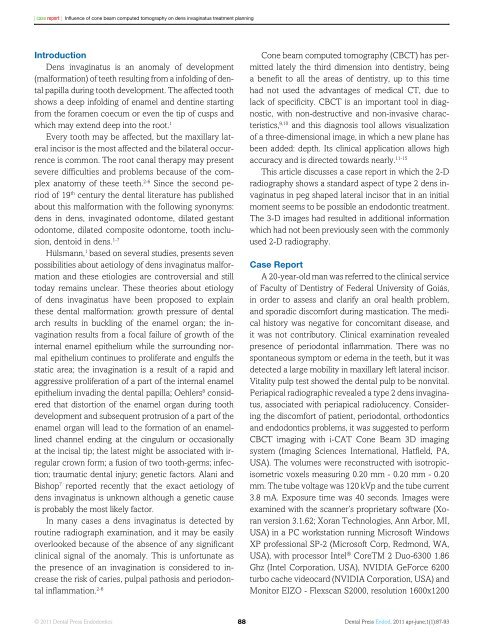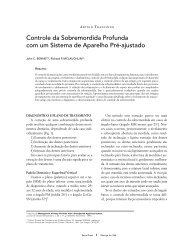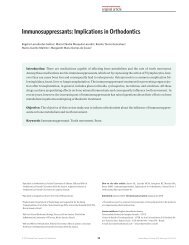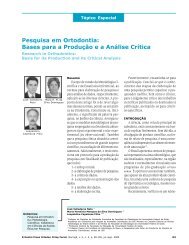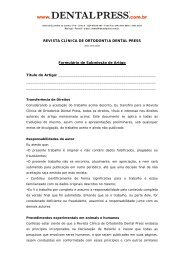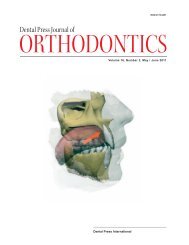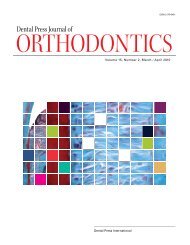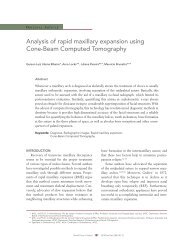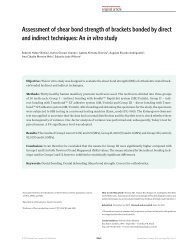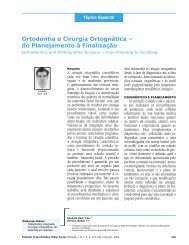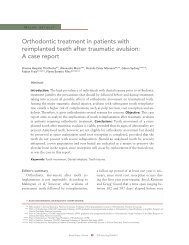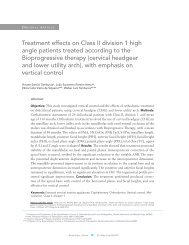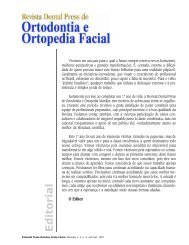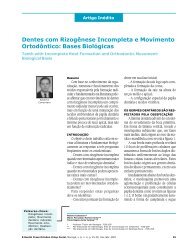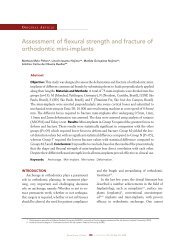Dental Press
Dental Press
Dental Press
Create successful ePaper yourself
Turn your PDF publications into a flip-book with our unique Google optimized e-Paper software.
[ case report ] Influence of cone beam computed tomography on dens invaginatus treatment planning<br />
Introduction<br />
Dens invaginatus is an anomaly of development<br />
(malformation) of teeth resulting from a infolding of dental<br />
papilla during tooth development. The affected tooth<br />
shows a deep infolding of enamel and dentine starting<br />
from the foramen coecum or even the tip of cusps and<br />
which may extend deep into the root. 1<br />
Every tooth may be affected, but the maxillary lateral<br />
incisor is the most affected and the bilateral occurrence<br />
is common. The root canal therapy may present<br />
severe difficulties and problems because of the complex<br />
anatomy of these teeth. 2-6 Since the second period<br />
of 19 th century the dental literature has published<br />
about this malformation with the following synonyms:<br />
dens in dens, invaginated odontome, dilated gestant<br />
odontome, dilated composite odontome, tooth inclusion,<br />
dentoid in dens. 1-7<br />
Hülsmann, 1 based on several studies, presents seven<br />
possibilities about aetiology of dens invaginatus malformation<br />
and these etiologies are controversial and still<br />
today remains unclear. These theories about etiology<br />
of dens invaginatus have been proposed to explain<br />
these dental malformation: growth pressure of dental<br />
arch results in buckling of the enamel organ; the invagination<br />
results from a focal failure of growth of the<br />
internal enamel epithelium while the surrounding normal<br />
epithelium continues to proliferate and engulfs the<br />
static area; the invagination is a result of a rapid and<br />
aggressive proliferation of a part of the internal enamel<br />
epithelium invading the dental papilla; Oehlers 8 considered<br />
that distortion of the enamel organ during tooth<br />
development and subsequent protrusion of a part of the<br />
enamel organ will lead to the formation of an enamellined<br />
channel ending at the cingulum or occasionally<br />
at the incisal tip; the latest might be associated with irregular<br />
crown form; a fusion of two tooth-germs; infection;<br />
traumatic dental injury; genetic factors. Alani and<br />
Bishop 7 reported recently that the exact aetiology of<br />
dens invaginatus is unknown although a genetic cause<br />
is probably the most likely factor.<br />
In many cases a dens invaginatus is detected by<br />
routine radiograph examination, and it may be easily<br />
overlooked because of the absence of any significant<br />
clinical signal of the anomaly. This is unfortunate as<br />
the presence of an invagination is considered to increase<br />
the risk of caries, pulpal pathosis and periodontal<br />
inflammation. 2-6<br />
Cone beam computed tomography (CBCT) has permitted<br />
lately the third dimension into dentistry, being<br />
a benefit to all the areas of dentistry, up to this time<br />
had not used the advantages of medical CT, due to<br />
lack of specificity. CBCT is an important tool in diagnostic,<br />
with non-destructive and non-invasive characteristics,<br />
9,10 and this diagnosis tool allows visualization<br />
of a three-dimensional image, in which a new plane has<br />
been added: depth. Its clinical application allows high<br />
accuracy and is directed towards nearly. 11-15<br />
This article discusses a case report in which the 2-D<br />
radiography shows a standard aspect of type 2 dens invaginatus<br />
in peg shaped lateral incisor that in an initial<br />
moment seems to be possible an endodontic treatment.<br />
The 3-D images had resulted in additional information<br />
which had not been previously seen with the commonly<br />
used 2-D radiography.<br />
Case Report<br />
A 20-year-old man was referred to the clinical service<br />
of Faculty of Dentistry of Federal University of Goiás,<br />
in order to assess and clarify an oral health problem,<br />
and sporadic discomfort during mastication. The medical<br />
history was negative for concomitant disease, and<br />
it was not contributory. Clinical examination revealed<br />
presence of periodontal inflammation. There was no<br />
spontaneous symptom or edema in the teeth, but it was<br />
detected a large mobility in maxillary left lateral incisor.<br />
Vitality pulp test showed the dental pulp to be nonvital.<br />
Periapical radiographic revealed a type 2 dens invaginatus,<br />
associated with periapical radiolucency. Considering<br />
the discomfort of patient, periodontal, orthodontics<br />
and endodontics problems, it was suggested to perform<br />
CBCT imaging with i-CAT Cone Beam 3D imaging<br />
system (Imaging Sciences International, Hatfield, PA,<br />
USA). The volumes were reconstructed with isotropicisometric<br />
voxels measuring 0.20 mm - 0.20 mm - 0.20<br />
mm. The tube voltage was 120 kVp and the tube current<br />
3.8 mA. Exposure time was 40 seconds. Images were<br />
examined with the scanner’s proprietary software (Xoran<br />
version 3.1.62; Xoran Technologies, Ann Arbor, MI,<br />
USA) in a PC workstation running Microsoft Windows<br />
XP professional SP-2 (Microsoft Corp, Redmond, WA,<br />
USA), with processor Intel ® CoreTM 2 Duo-6300 1.86<br />
Ghz (Intel Corporation, USA), NVIDIA GeForce 6200<br />
turbo cache videocard (NVIDIA Corporation, USA) and<br />
Monitor EIZO - Flexscan S2000, resolution 1600x1200<br />
© 2011 <strong>Dental</strong> <strong>Press</strong> Endodontics 88<br />
<strong>Dental</strong> <strong>Press</strong> Endod. 2011 apr-june;1(1):87-93


